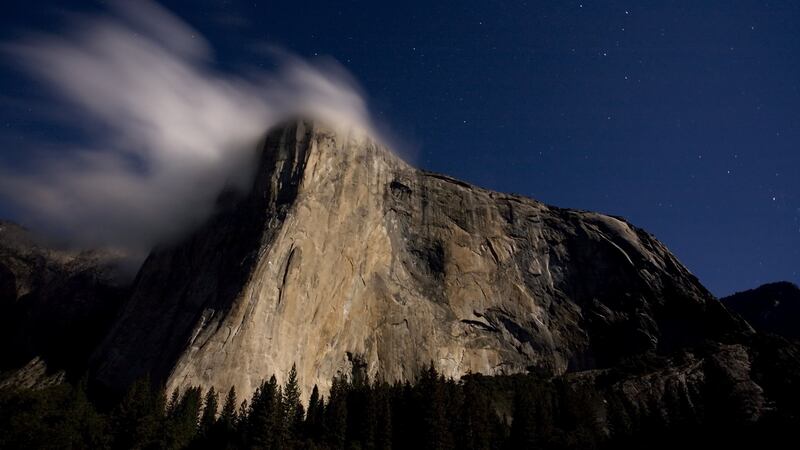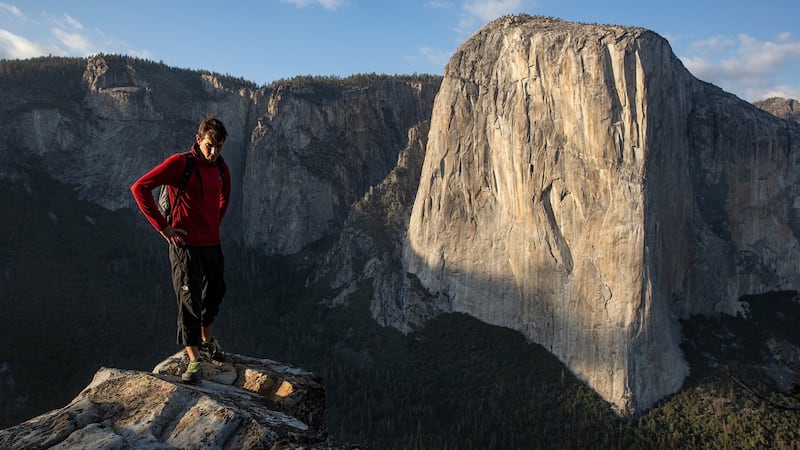Live Beyond Fear. Nobody knows what it really means. It is the slogan for the Oscar winning documentary Free Solo, a mesmerising film about a nerveless American rock climber and reluctant screen star Alex Honnold. Actually, that’s not what it’s about at all.
It’s about Alex Honnold moving the sport of rock climbing from a dynamic, risky outdoor pursuit to a life changing project that has shifted its boundaries beyond the reach and comprehension of most people. No, that’s not it either.
It’s about Alex Honnold, a southern Californian geek, an outlier, an emotionally listless, self-isolating climber, who does fingertip pull-ups on the door of his camper van for breakfast and without rope conquers the 3,000 foot granite slab of El Capitan (El Cap) in Yosemite, California for the first time, the only time. He does El Cap in climbing shoes, cut-off shorts, a red T-shirt and a bag of chalk. No, that’s not it either.
It’s about Alex Honnold challenging physical and mental limits. It’s about finding the moment to do it. It’s about trusting that a clenched fist in a fissure will save you from falling to certain death. It’s about not fearing that forefinger and thumb pressure points on a chip of rock will give way more than half a mile up on an overhang. It’s coming to an agreement with mortality. But that’s not it either.
It’s about a 22-year-old who calls food fuel and spoons what he cooks straight from the pan because there’s no need for plates. It’s about the shot of his leg coming up over an outcrop before the rest of his body and thinking ‘that’s not possible’. It is where any error is rewarded with death. It’s where any doubt is rewarded with death. It’s where any anxiety is rewarded with death. It’s where any human frailty is rewarded with death. It’s where the people filming the spectacle point their cameras and turn away because what he is doing is almost not human. But that’s not it either.
*********************

Honnold parked his campervan and alone in the morning dusk hiked up the trail to the base of El Cap in Yosemite National Park, California. It was June, 2017 and he had walked the same path some months before. Back then something wasn’t right and after less than an hour he walked away.
This time it was just after 5.30am when he lurched forward onto the granite monolith and began to gracefully move upwards. Those first few toeholds were the beginning of rock climbing history and arguably the greatest athletic feat ever accomplished.
Called ‘free soloing’, Honnold had no margin of error on his ascent. Distinct from free climbing, where climbers use no equipment to help them move up the mountain but are attached to ropes to catch them if they fall, Honnold had just chalk and rubber-soled climbing shoes.
The 31-year-old had already astonished the climbing world with free solos of the Half Dome in Yosemite and Moonlight Butress in Utah. But El Cap was of a different order of astonishing.
“What Alex did on Moonlight Buttress defied everything that we are trained, and brought up and genetically engineered to think,” film maker Peter Mortimer told National Geographic. “It’s the most unnatural place for a human to be.”
El Cap wasn’t even in the thinking of the world’s best rock climbers other than in a wishful fantasy kind of way with the ‘Freerider’ route that Honnold chose covering 30 sections. It was the most prized of the big climbs in Yosemite.
To imagine the mounting risk involved Honnold tracked upwards to 600 feet where the first significant threat was an erosion-polished slab of rock with no holds called the Freeblast. He climbed it using a technique he calls smearing, where he pressed the rubber of his sole against the rock to give the lightest of grips, just enough to take his weight and delicately move up.
He then traced upwards negotiating a traverse to the left at around 800 feet, where it was impossible to continue with a straight route, forcing him to climb down the rock and to one side in order to again ascend.
He had another downwards climb into Hollow Flake then upwards again into a difficult traverse at El Cap Spire, some 1,500 feet from where he had started. Teflon Corner and the boulder problem were a few hundred feet higher.
Here, barely visible to the human eye from the ground, his T-shirt lightly flapping in the breeze and with a one eighth of an inch hand-hold he leaned sideward with one leg to catch a nub of cliff almost 2,000 feet above Yosemite Valley. He called it the karate kick move.
With a flow to his movement that is both limber and terrifying, Honnold later described the choreography to beat what he called the crux, or the boulder problem part of the climb.
“Drive up off the left foot into the thumb press, roll two fingers over the thumb, switch feet, left foot out to a bad sloping foothold, switch thumbs, reach out left to a grainy rounded hold before launching into the karate kick.”

There are many climbers with Honnold’s wiry physique, who can suspend from their fingertips, jam their hands into a crack and form a fist that will hold their weight. There are many at the cutting edge of the sport, who can wedge their bodies between the two sides of a chimney and push up the rock face. There are many with his endurance and his fearlessness.
But none have been able to control their fear as Honnold did on El Cap. None have been able to suppress the anxiety and human response to such unimaginable levels of danger. Always composed, doubt and panic muzzled, sometimes hanging in thin air only by his fingertips. Honnold has spoken about it many times.
“With free soloing, obviously I know that I’m in danger, but feeling fearful while I’m up there is not helping me in any way,” he said. “It’s only hindering my performance, so I just set it aside and leave it be.”
The climb took two years of preparation, abseiling down from the top to see where he could pinch a ripple in the rock, or find purchase on an indent. He climbed all over El Cap using ropes, hanging more than 2,000 feet from the ground meticulously marking the holds and pressure points of the Freerider route, with its thousands of moves.
Roped, he had tried and failed many times at the most perilous part of the climb before the karate kick was finally mastered.
“Walking to the base, it was still quite dark. I started slightly earlier than I had been because I wanted to make sure I was the first [climber] at the base. I saw a bear running away on the walk in. I think I flushed him,” Honnold told his friend, climber and writer Mark Synnott.
“At the bottom I was slightly nervous. I mean it’s a freaking big wall above you. It’s like – it’s something. And then on the Freeblast, I was slightly tense, but felt really good.
“Physically [the climb] is not that hard to execute. It’s more you have to be in exactly the right [mental] place. So I was trying to create the right place.”
Only two other climbers had ever publicly expressed interest in climbing El Cap before Honnold did it. One was Michael Reardon, who drowned in Kerry in 2007. In an affidavit read to the inquest in Cahersiveen, Los Angeles photographer Damien Corso said he was accompanying the rock climber and was taking photographs when the accident happened.
Reardon had just climbed a section of rock on Valentia island near the Coast Guard station three times without a rope. He was standing on a flat piece of rock covered with algae when a large wave knocked him off and he was swept out to sea. The other climber was Dean Potter, who died in a base jumping accident in Yosemite in 2015.
After Honnold’s moment at the crux had passed and his karate kick held, he sped up past The Block and final Freerider section to almost 3,000 feet. After three hours 56 minutes he hauled himself onto a ledge it has taken climbers days to reach with ropes, his goofy smile betraying little of the insanity of it all.
“This is the ‘moon landing’ of free soloing,” said fellow climber Tommy Caldwell.
*********************

A moon landing. That’s what Alex Honnold is about. It’s about watching him exposed 600 feet from the summit, a speck, almost unseeable, the normal human instincts of fear disabled. It’s about the uncomfortable magnification of our fears, the pangs of guilt that maybe we are not actually living.
It’s about the recurring dream of being high on the ledge. It’s that dread, when you fall and you realise you have so much time before the ground hits, you can feel the wind rush past, the sensation of freewheeling through the air, the shrinking distress that has your worried mother rush into your room in the middle of the night.
It’s about what it says, Alex Honnold living beyond fear.























